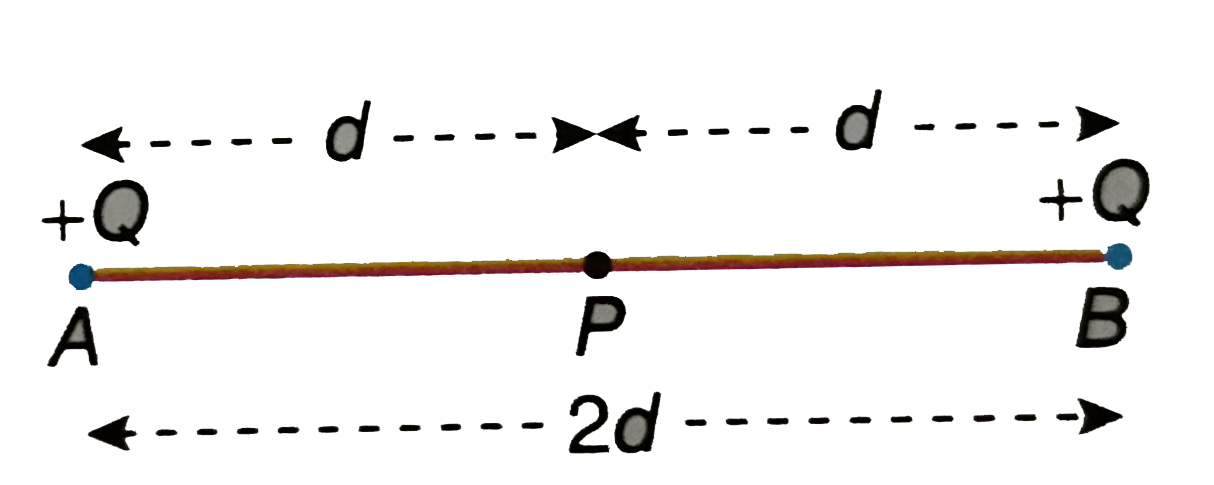The distance between two points A and B in vacuum is 2d. At each of these two points a + Q charge is placed. P is the midpoint of AB. Find the intensity and potential at P due to the electric field. How will the values of these quantities change if the charge at B is replaced by a charge -Q ?Solution in Bengali
AB−2d,mid point ofABisP,i.e.,AP=BP=d

Intensity at P due to the charge +Q at A
Qd2, along −−→PB …………(1)
Intensity at P due to the charge + Q at B
=Qd2,along−−→PA ...............(2)
So, intensities at P due to the charges at A and B are equal and opposite.
Therefore, the resultant intensity at P is zero.
Potential at P due to the charge at A=Qd ..........(3)
Potential at P due to the charges at B=Qd ..............(4)
∴ Total potential at P=Qd+Qd=2Qd.
Now if -Q charge be placed at the point B, intensity in equation (2) Will be Qd2 along −−→PB
∴ Resultant intensity at P=Qd2+Qd2=2Qd2, along −−→PB
Again the value of potential in equation (4) will be −Qd.
∴ Total potential at P=Qd−Qd=0.
Topper's Solved these Questions
- ELECTRIC POTENTIAL BOOK - CHHAYA PUBLICATIONCHAPTER - ELECTRIC POTENTIAL EXERCISE - Section related questions
25 Videos
- ELECTRIC POTENTIAL BOOK - CHHAYA PUBLICATIONCHAPTER - ELECTRIC POTENTIAL EXERCISE - Higher order thinking skill (HOTS) questions
23 Videos
- ELECTRIC FIELDBOOK - CHHAYA PUBLICATIONCHAPTER - ELECTRIC FIELDEXERCISE - CBSE SCANNER
31 Videos
- ELECTROMAGNETIC INDUCTION & ALTERNATING CURRENTBOOK - CHHAYA PUBLICATIONCHAPTER - ELECTROMAGNETIC INDUCTION & ALTERNATING CURRENTEXERCISE - CBSE SCANNER
28 Videos
Similar Questions
What do you mean by potential of a charged body?
View SolutionIf the intensity at a point in an electric field is zero, will the electric potential be also zero at that point? If the electric potential be zero at a point, will the intensity be also zero at the point?
View SolutionA charge q is placed at the centre of a cube of side l. What is the electric flux passing through each face of the cube?
View SolutionA bar magnet is moved in the direction indicated by the arrow between two coils PQ and CD. Predict the directions of induced current in each coil.

View SolutionA point charge q_1=q is placed at point P. Another point charge q_2=-q is placed at point Q. At some point R(R!=P, R!=Q) , electric potential due to q-1 is V_1 and electric potential due to q_2 is V_2 . Which of the following is correct
View SolutionElectric field intensity at a point B due to a point charge Q kept at a point charge Q kept at point A is 24 NC^(-1) , and electric potential at B due to the same charge is 12 JC^(-1) . Calculate the distance AB and magnitude of charge.
View Solutionदो आवेश +q व -q एक - दूसरे से कुछ दूरी पर रखे हैं । यदि उनके बीच मध्य बिंदु पर विद्युत क्षेत्र व E विभवान्तर V हैं , तो
View SolutionA point P is at a distance r from a point charge q. if at point P, the electric potential is 300 V, and the electric field intensity is 75 V/m, then the distance of P from the point charge is
View SolutionIn vacuum, four charges each equal to q are placed at each of the four vertices of a square. Find the intensity and potential of the electric field at the point of intersection of two diagonals.
View SolutionTwo point charges are placed on the y - axis at y=+aandy=−a in vacuum. The magnitude of each charge is q. Determin the electric field intensity at P(x,0) on the x - axis.
View Solutionबिन्दु आवेश Q के कारण r दूरी पर विद्युत् क्षेत्र की तीव्रता E है-
View Solution" Electric field intensity due to a point charge " "q" ' at a distance 'r' from it is "
View Solutionदो बिंदु आवेश qA=3μC तथा qB=−3μC निर्वात में एक-दूसरे से 20 cm दुरी पर स्थित है।
दोनों आवेशों को मिलाने वाली रेखा AB के मध्य बिंदु O पर विधुत क्षेत्र कितना है ?
View SolutionThe magnitude of electric field intensity and potential at a point A due to a charge Q placed at point B are 25NC^(-1) and 35JC^(-1) , respectively. Calculate the value of Q and distance between A and B.
View SolutionConsider a point charge +q placed at the origin and another point charge -2p placed at a distance of 9 m from the charge +q . Determine the point between the two charges at which electric potential is zero.
View Solution
